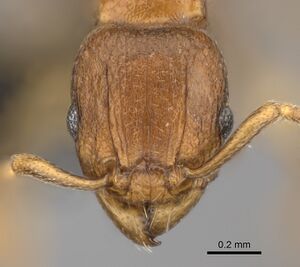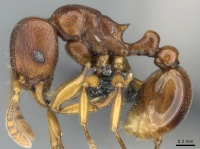Tetramorium freya
| Tetramorium freya | |
|---|---|

| |
| Scientific classification | |
| Kingdom: | Animalia |
| Phylum: | Arthropoda |
| Class: | Insecta |
| Order: | Hymenoptera |
| Family: | Formicidae |
| Subfamily: | Myrmicinae |
| Tribe: | Crematogastrini |
| Genus: | Tetramorium |
| Species group: | schaufussii |
| Species complex: | cognatum |
| Species: | T. freya |
| Binomial name | |
| Tetramorium freya Hita Garcia & Fisher, 2014 | |
Tetramorium freya was mostly sampled from Malaise traps or from vegetation and only once from leaf litter; considering there are only five known specimens, it seems likely that T. freya nests and forages in vegetation. Additional sampling in lower vegetation might yield more material of this otherwise very rare species. (Hita Garcia and Fisher 2014)
Identification
A member of the Tetramorium cognatum species complex of the Tetramorium schaufussii species group. The following character combination distinguishes T. freya from the other species of the T. cognatum species complex: frontal carinae weakly developed, merging with surrounding sculpture halfway between posterior eye margin and posterior head margin; petiolar node high nodiform with well rounded margins, in profile around 1.6 to 1.7 times higher than long (LPeI 58–62), in dorsal view 1.2 to 1.3 times wider than long (DPeI 124–131); lack of any long, standing pilosity on dorsal mesosoma.
The identification of T. freya is easy and straightforward since it is the only species of the species complex without any long, standing pilosity on the mesosomal dorsum. Beyond mesosomal pilosity, T. freya also has weakly developed frontal carinae and sculpture on the head and mesosoma, which separate it from Tetramorium gladius, Tetramorium myrmidon, Tetramorium proximum, and Tetramorium tenuinode. In addition, T. freya possesses a stouter and higher mesosoma (LMI 40–42) and a lower and thicker petiolar node (LPeI 58–62, around 1.6 to 1.7 times higher than long) compared to Tetramorium aspis, Tetramorium camelliae, Tetramorium cognatum, Tetramorium karthala, and Tetramorium rumo (LMI 35–40; LPeI 33–55, around 1.8 to 3.0 times higher than long).
Based on the limited number of specimens available for this study, there seems to be no significant intraspecific variation in T. freya.
Keys including this Species
Distribution
Tetramorium freya is a rare species only known from a few localities at the northernmost tip of Madagascar and from the island of Nosy Be.
Latitudinal Distribution Pattern
Latitudinal Range: -12.26278° to -13.41933°.
| North Temperate |
North Subtropical |
Tropical | South Subtropical |
South Temperate |
- Source: AntMaps
Distribution based on Regional Taxon Lists
Malagasy Region: Madagascar (type locality).
Distribution based on AntMaps
Distribution based on AntWeb specimens
Check data from AntWeb
Countries Occupied
| Number of countries occupied by this species based on AntWiki Regional Taxon Lists. In general, fewer countries occupied indicates a narrower range, while more countries indicates a more widespread species. |

|
Estimated Abundance
| Relative abundance based on number of AntMaps records per species (this species within the purple bar). Fewer records (to the left) indicates a less abundant/encountered species while more records (to the right) indicates more abundant/encountered species. |

|
Habitat
The species was collected in rainforests, dry forests, and coastal dunes at elevations from 10 to 1000 m.
Biology
Castes
Images from AntWeb
   
| |
| Worker. Specimen code casent0466944. Photographer Will Ericson, uploaded by California Academy of Sciences. | Owned by CAS, San Francisco, CA, USA. |
Nomenclature
The following information is derived from Barry Bolton's Online Catalogue of the Ants of the World.
- freya. Tetramorium freya Hita Garcia & Fisher, 2014: 76, figs. 21A, 33, 63 (w.) MADAGASCAR.
Unless otherwise noted the text for the remainder of this section is reported from the publication that includes the original description.
Description
Worker
(N=5). HL 0.61–0.74 (0.68); HW 0.56–0.68 (0.62); SL 0.40–0.46 (0.44); EL 0.14–0.17 (0.16); PH 0.30–0.35 (0.33); PW 0.38–0.43 (0.40); WL 0.72–0.87 (0.81); PSL 0.12–0.15 (0.13); PTL 0.13–0.16 (0.15); PTH 0.21–0.27 (0.25); PTW 0.17–0.20 (0.19); PPL 0.16–0.21 (0.19); PPH 0.22–0.28 (0.25); PPW 0.23–0.28 (0.25); CI 90–92 (91); SI 68–71 (70); OI 25; DMI 44–54 (50); LMI 40–42 (41); PSLI 18–20 (19); PeNI 42–50 (46); LPeI 58–62 (59); DPeI 124–131 (127); PpNI 59–70 (63); LPpI 72–77 (75); DPpI 127–144 (134); PPI 133–140 (136).
Head much longer than wide (CI 90–92); in full-face view posterior head margin weakly concave. Anterior clypeal margin with distinct median impression. Frontal carinae weakly to moderately developed, merging with surrounding sculpture halfway between posterior eye margin and posterior head margin. Antennal scrobes weak to absent, shallow and without clear and distinct posterior and ventral margins. Antennal scapes very short, not reaching posterior head margin (SI 68–71). Eyes relatively large (OI 25). Mesosomal outline in profile weakly to moderately convex, moderately high and stout (LMI 40–42), weakly to moderately marginate from lateral to dorsal mesosoma; promesonotal suture absent; metanotal groove present, but weakly developed. Propodeal spines short, triangular to elongate-triangular, and acute (PSLI 18–20), propodeal lobes triangular and short, always much shorter than propodeal spines. Petiolar node in profile high nodiform with well-rounded margins, around 1.6 to 1.7 times higher than long (LPeI 58–62), anterior and posterior faces approximately parallel and rounding smoothly onto dorsum, anterodorsal and posterodorsal margins situated at about same height, petiolar dorsum relatively noticeably convex; node in dorsal view 1.2 to 1.3 times wider than long (DPeI 124–131), in dorsal view pronotum between 2.0 to 2.4 times wider than petiolar node (PeNI 42–50). Postpetiole in profile globular to subglobular, between 1.3 to 1.4 times higher than long (LPpI 72–77); in dorsal view around 1.3 to 1.4 times wider than long (DPpI 127–144), pronotum between 1.4 to 1.8 times wider than postpetiole (PpNI 59–70). Postpetiole in profile appearing approximately as voluminous as petiolar node, postpetiole in dorsal view around 1.3 to 1.4 times wider than petiolar node (PPI 133–140). Mandibles completely unsculptured, smooth, and shiny; clypeus in parts irregularly longitudinally rugulose, median ruga never fully developed, usually reduced to a few traces, one or two irregular and broken lateral rugulae present on each side; cephalic dorsum between frontal carinae weakly irregularly longitudinally rugulose, rugulae weak, often interrupted or with cross-meshes and becoming much weaker posteriorly; scrobal area mostly irregularly longitudinally rugulose and merging with surrounding irregularly longitudinally rugose to reticulate-rugose sculpture present on lateral head. Head with very conspicuous punctate ground sculpture. Mesosoma laterally and dorsally with traces of irregular rugulae or reticulate-rugose sculpture overlaying a distinct punctate ground sculpture. Forecoxae in parts weakly longitudinally rugulose and partly unsculptured, smooth, and shining. Both waist segments and gaster fully unsculptured, smooth, and shining. Dorsum of head with several pairs of hairs. Mesosoma, waist segments, and first gastral tergite without any standing hairs at all; first gastral tergite with very short, moderately dense, and appressed pubescence. Anterior edges of antennal scapes and dorsal (outer) surfaces of hind tibiae with appressed hairs. Head, mesosoma, waist segments, and gaster uniform brown, appendages yellowish to light brown.
Type Material
Holotype, pinned worker, MADAGASCAR, Antsiranana, Diego-Suarez, 7 km N Joffreville [camp 2 of Fisher], 12.33333°S, 49.25°E, 360 m, in dry forest, Malaise trap, collection code MA-01-07-08, 6.–20.III.2001 (R. Harin’Hala) (California Academy of Sciences: CASENT0085551). Paratype, one pinned worker with same data as holotype except collected 20.III.–7.IV.2001 and collection code MA-01-07-09 (CASENT0083419).
Etymology
The name of the new species was inspired and derived from the name of the Old Norse goddess Freyja (which means “Lady” in Old Norse) who was considered the goddess of love, beauty, fertility, war, and death. As a name taken from Norse mythology, it is treated as an arbitrary combination of letters, thus invariant.
References
References based on Global Ant Biodiversity Informatics
- Hita Garcia F, and B. L. Fisher. 2014. The hyper-diverse ant genus Tetramorium Mayr (Hymenoptera, Formicidae) in the Malagasy region - taxonomic revision of the T. naganum, T. plesiarum, T. schaufussii, and T. severini species groups. ZooKeys 413: 1-170.

